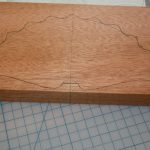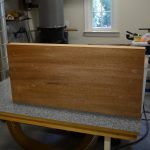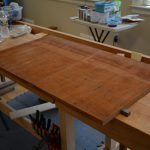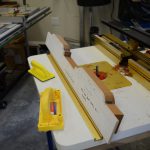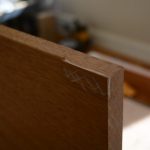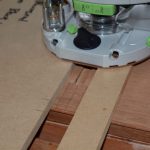We are now at the foot construction phase of the project, the bracket feet on the John Townsend block and shell chest. First we will start with the construction of the rear bracket feet.
All of the bracket feet for this chest where cut from this single billet of Mahogany..
After layout of the feet, the side profile of the feet are bandsawn.
The back foot on this chest is sliding dovetailed into the rear foot. Here we first see a dado being cut into the rear foot to ease the strain on the dovetail bit, the next picture shows the sliding dovetail pin being cut in the rear foot.
Next the sliding dovetail “tail” is cut into the back foot.
Here we see the back foot assembled and glued, also note that the side profile of the rear foot has been drawn onto the rear foot.
The side profile of the rear foot will be shaped at the bandsaw. Here we see the back foot secured on a platform 90 degrees to the blade, we then shape the profile of the rear ogee foot.
The rear ogee foot on this chest are unusual in that the back edge of the rear ogee foot receives the same profile as the side of the foot. The trick is how to properly draw the profile on the back of the rear foot, after the rear foot has already been shaped? The trick that I am using was borrowed from none other than Alf Sharp (I borrow ideas from the best), using a scrap of poplar the side profile of the rear foot it sawn into the scrape, the “waste” portion of the scrap is kept. Next the profile for the back edge of the right and left rear ogee foot, is drawn on the scrape and bandsawn. The scrap is now registered on the rear foot (as shown the right rear foot) and the profile is traced ontp the foot..
The profile of the back of the rear right foot..
Next it’s bandsawn…
Now onto the front feet, the front feet are mitered and glued with a spline.
Lets talk about the front feet on a “Newport style” block and shell chests, the sides of the front feet are constructed and can be shaped like a typical ogee foot. The front feet follow the shape of the “blocking” of the front of the chest, to further complicate matters, as the “blocked” portion of the front foot gracefully meets the “non-blocked” portion of the front foot, the transition is terminated with a volute..
After the glued has cured, the assembled front foot is mounted to a platform and the profile of the sides of the front feet are bandsawn to shape (we are shaping the non-blocked, right and left sides of the front foot).
Next the front foot is mounted into another platform that registers the bottom of the foot, 90 degrees to the bandsaw blade. We use one of the offcuts to assist with the clamping. Notice the portion of the front foot that is marked with white pencil, this area will be removed from the front of the foot, removing this waste will make carving the front foot easier and quicker.
Here is the front foot after the “non-blocked” portion of the waste is removed, notice that we stop short of the tell tale glue line with the waste removal. The profile of the front foot “non-blocked” portion of the foot can clearly be seen in this photo..
Next the foot is clamped in a shoulder vise and the termination shape of the “blocked” portion of the front foot is drawn on the foot (notice the pattern on the work bench). In the next step the portion marked with white pencil will need to be removed with carving gouges.
Removing the waste.
Blocked termination rough out complete.
Next the “non-blocked” profile of the front foot is carved, this task is not as daunting as it seems, as the glue line at the miter shows what material must be removed,,
Next the profile for the “blocked” portion of the front foot must be shaped and carved (volute). This task is slow and tedious, lots of removing wood and testing the fit on the front of the chest. Here I use a scribe to mark the rough shape of the “blocked” portion of the foot, the shape of the “blocked” portion as see from the top is marked directly from the the front molding..
Here is a what the completed front foot should look like test fit, unfortunately I neglected to take any photos of the carving of the volute.
